 |
Here are the various folding cameras in my collection (not including Kodak Retinas and Agfa Karats that have their own pages).
Other types of cameras can be found elsewhere:
TLR cameras
focal plane shutters
SLR cameras
Thornton-Pickard Imperial 'Triple Extension'
In the early days of photography, cameras were hand-crafted items requiring great skill and dedication to build as well as operate. Film was not the ubiquitous item it would later become, so other mediums such as sensitised plates were often used. Film enlargers were also uncommon, so generally the 'negatives' would be size of the eventual print, requiring the cameras to be large. Optical lens design was still in its infancy. Yet, impressive results were and still are possible with these over a century-old cameras.
I've always wanted to own one of these magnificent pieces of history, but they are not cheap, and the variety in types and models is quite overwhelming, so it's not something to do on a whim. Eventually the choice came down to a Thornton-Pickard Imperial half plate camera. It came with a working shutter, which Thornton-Pickard was most well-known for, and which gave me the opportunity to find out how these worked. Turns out not that different from later focal plane shutters but with a single roller and a fixed gap in the curtain, requiring the roller to move at different speeds for different exposure times, and the lens need to be capped when arming the shutter in order not to expose the film prematurely.
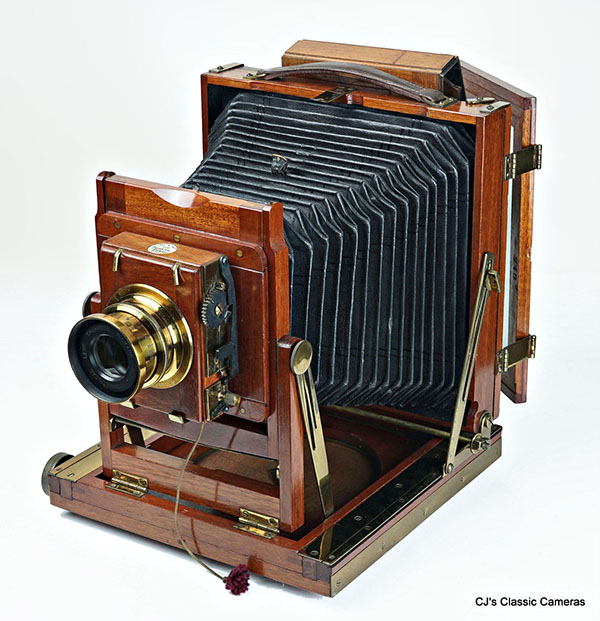
A Thornton-Pickard Imperial 'Triple Extension' with Beck Symmetrical 8 inch f/8 lens with adjustable aperture from the late 1910s or early 1920s. The cord with the small purple pompom was used to arm the Thornton-Pickard 'Time and Instantaneous' shutter.
The camera itself has many adjustments such as tilt and shift, as well as an extension rail to allow close focus. It folds up to a small box of only about 6 cm thick although one needs to remove the lens. The camera needed to be focussed using a frosted glass screen at the back, which could be swung away making room to insert a sensitised plate or so-called double dark slide containing film. Working this really makes you appreciate how difficult a skill photography was in the early days, and how easy is has become nowadays from a technical point of view.
Zeca Goldi
Zeh is a relatively unknown pre-WWII camera maker from Dresden (the home of Zeiss, Altissa and Certo amongst others), but the Zeca cameras had a reputation of being well-build and engineered. The Zeca Goldi was no exception, it was a folding camera for 127 film with an extremely sturdy scissor-strut construction, later also used on the Zeca-Flex, Zeh's top of the range folding TLR camera. Supporting its good reputation was the fact that the Goldi was one of the few cameras that were sold with Leitz Elmar lenses, the only other ones I can think of were the Nagel Pupille and the Nagel/Kodak Vollenda. However, the latter two had unit focussing mechanisms, whereas the Elmar on the Goldi was a front cell focussing variant. So this may have been the only front cell focussing Elmar that Leitz produced, but let me know if I am wrong.
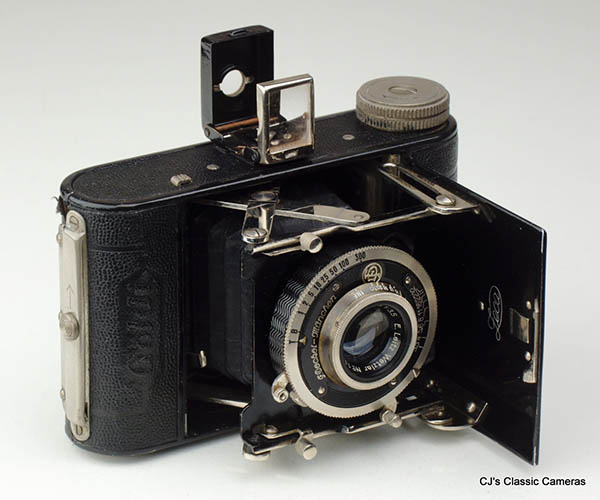
A 3x4 format Zeca Goldi with Leitz Elmar 50mm f/3.5 lens in Compur shutter from around 1934.
|
Same 3x4 format Zeca Goldi in upright position.
|
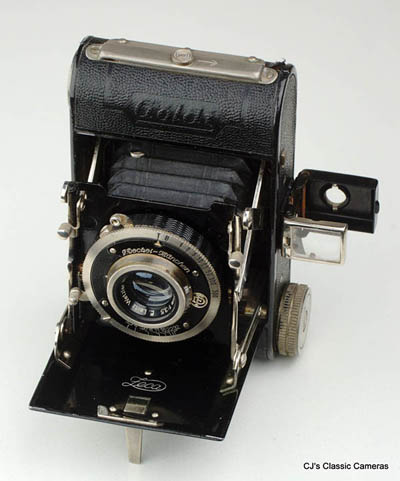
|
The Goldi was rebranded under several names, the Rodenstock Ysella is the most well known, but also as Coloprint, Imperial and Ralikona. Nearly all Goldi's were halfframe 3x4 cameras, but I happened to stumble upon a rare 6x4 version as well (which I only realised after receiving it!).
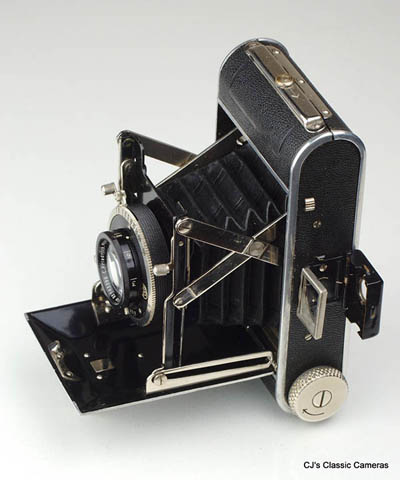
|
A 6x4 format Zeca Goldi with C. Friedriech Munchen Corygon-Anastigmat 75mm f/3.5 lens in Compur shutter from around 1933. This is an unmarked example, i.e., missing the Zeh Goldi name, so perhaps it was sold originally under a different name. It is the only image of a 6x4 Goldi variant I have been able to find on the internet, although their existence has been mentioned on a few forum posts.
The very stable strut system (often the bane of folding cameras) can be folded simply by pushing down on two small levers, keeping the lens board parallel at all times.
|
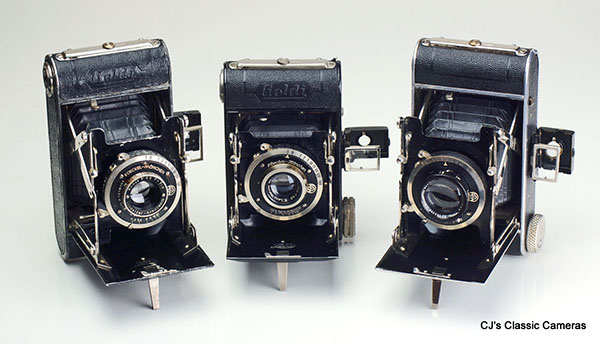
Ironically, not long after coming into possession of the non-branded 6x4 Goldi, a real one come along. Here they are all shown side by side, clearly showing the difference in size. Also note the different viewfinders, an easy means of checking which version it is. The Goldi-branded 6x4 is on the left, it sports a Schneider-Kreuznach Xenar 70mm f/4.5 lens which can be dated to winter 1934 (these early Xenars had the serial engraved on the rear element ring).
|
Rodenstock Ysella, a rebranded Zeca Goldi. Surprisingly, it does not have a Rodenstock lens, which makes me suspect the lens and perhaps even the shutter were swapped with another camera.
|
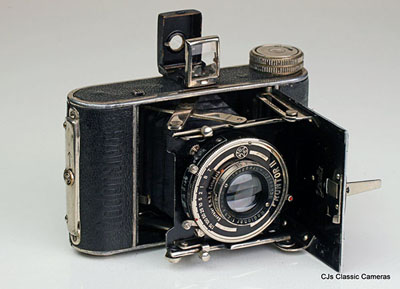
|
Zeh Zeca-Flex
The Zeh Zeca-Flex was a rather unusual camera. It was one of the few folding TLRs that have ever been made, other being the Perfekta/Super Perfekta, KW Pilot and Taylor Hobson xxxx? The Zeca-Flex was quite a magnificent camera in some aspects, but quite poor in other. On the plus side was was a well-build medium format TLR camera with frame counter and high spec lens and shutter combinations in a relatively compact package, but it was let down by its small viewfinder and fairly complicated operation.
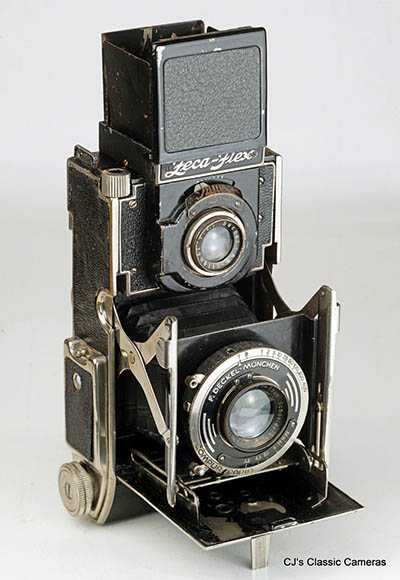
| | The rather unusual Zeh Zeca-Flex folding TLR, here with Schneider Xenar lens in Compur-Rapid shutter. This example has seen better days, but is mostly functional. Note the focus knob to the left of the Zeca-Flex nameplate. Turning these would extend or retract the struts on which the taking lens board was mounted, and rotate the viewing lens to match the taking lens focus.
Note that the waist-level viewfinder cover plate is a later replacement.
|
The small viewfinder was a common problem of folding TLRs, as the viewfinder needed to be relatively small to be able to fit on top of a folding body, as making the viewfinder bigger would defeat the small form factor of the camera.
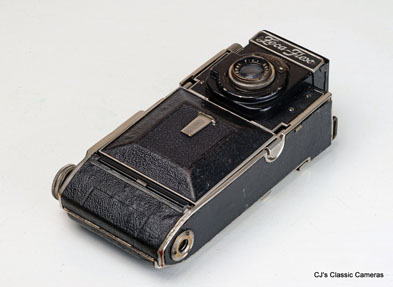
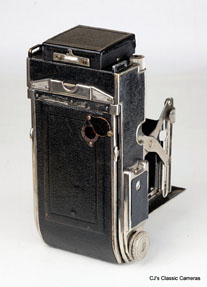
(left) Zeh Zeca-Flex fully folded up. Move mouse over the image to see the struts extended. (right) Rear view of the Zeca-Flex. The red spy window was used for loading film, but for winding the film a frame counter on the side of the camera was used. Although the camera was large enough to give the impression of being a 6x9 camera, it was only 6x6 as the extra space was needed for the viewfinder mirror.
|
Merkel Metharette
Merkel was a small camera maker founded in 1900 in Tharandt near Dresden, mainly known from the Reflecta TLR camera (one of the earliest TLRs) introduced in 1932 around the same time as the company was taken over by Richter. The Merkel Metharette was a small strut-folding rollfilm camera for 127 film introduced around 1930. It had quite a characteristic strut mechanism (see photo below) and a baseplate with four embossed corners. The baseplate would move to its forward position upon pushing the release button at the bottom of the camera, and the viewfinder would pop up at the same time. To close the camera one simply pushed the baseplate back into the camera body.
Several different variants of the camera were build, including versions for other companies as the models often bear different names, such as Primula and Embirella (the latter reportedly sold by the Czech company Birnbaum). The Rodenstock Rodella certainly was a rebadged Metharette, and so was the Salmoiraghi Gioia (the name!) for a camera maker in Milan. Apparently a variant was also sold by Meyer (better known for its lenses) as the Megor, but more commonly found is a copy of the Korelle 127 3x4 folding camera with the same name, which had struts on the side of the baseplate instead of at the top and bottom like on the Metharette (see below for an example). It does not help the confusion surrounding the Merkel Metharette that neither the name of the camera or its maker was indicated on the camera.
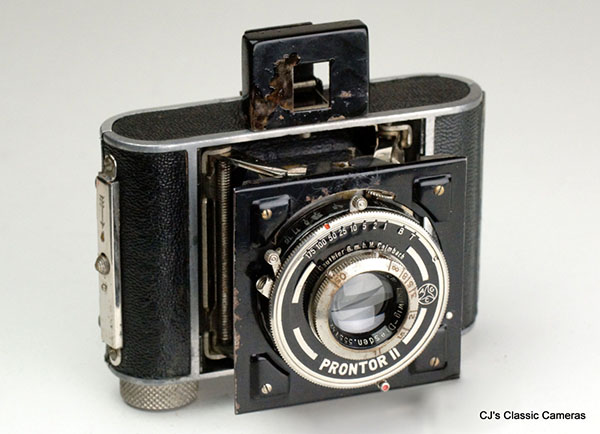
A Merkel Metharette with Ludwig-Dresden Victar 50mm f/2.9 lens in Prontor II shutter.
Meyer Megor (Kochmann Korelle 3x4)
Meyer was a well-known lens maker located in Görlitz (close to the Polish-German border) that also sold rebranded cameras under its own name, of course equipped with its own lenses. This was not uncommon at the time (the 1930s), e.g., Rodenstock did the same (see Rodenstock Citonette and Rodinett below). The Meyer Megor was a copy of the 3x4 Kochmann Korelle for 127 rollfilm. It had a spring-supported strut mechanism that could be closed by simply pushing it in. According ads from the time it was available with Meyer Trioplan, Primotar or Makro-Plasmat lenses, but the first was certainly the most common. Kochmann itself was one of the many camera companies based in Dresden, not far from the Meyer factories. Its specialty was small 'vest pocket', handsome cameras, many of them folding cameras, like indeed the Korelle 3x4.
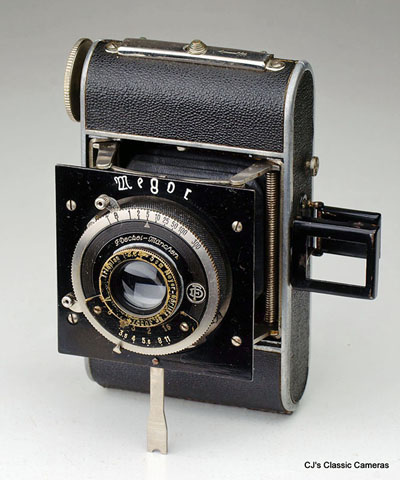
|
A 1933 Meyer Megor (Kochmann Korelle 3x4) with Meyer Trioplan 50mm f/3.5 lens in Compur shutter.
|
According sources on the internet there was a second version of the Megor, which was a rebadged Merkel Metharette (see above). This is not a surprise, the Metharette appeared under many different names. However, the examples I have seen on the internet do not have Meyer lenses (e.g., here), so I suspect these were incorrectly identified as being Megors. In fact, a search for Metharette (or any of its rebranded versions) with Meyer Trioplan gives no results, so in my opinion the existence of this second Megor version is uncertain.
It appears the Megor was the only camera sold by Meyer. Like so many east-German companies, Meyer Optik was after WWII taken up in VEB Pentacon/Carl Zeiss. However, the name has recently be revived by a G rlitz-based company producing modern versions of the classic lenses.
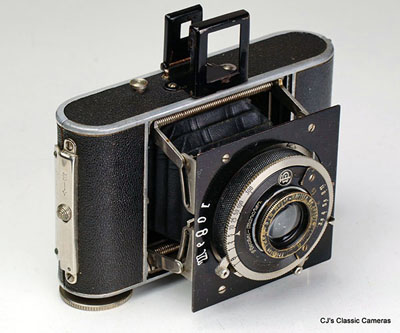
|
A different view of the same Meyer Megor.
|
Rodenstock Rodinett (Glunz Ingo)
Glunz was a now fairly obscure camera maker from Hannover, Germany, mainly known for the medium and large format plate and folding cameras that it made during the 1920s to early 1930s. However, it had one surprise on its sleeve: the Glunz Ingo. This was a small folding camera for 127 rollfilm with a pop-up strut mechanism, not unlike the Merkel Metharette and Meyer Megor above. Indeed, the popularity of these models may well have been the inspiration for Glunz to build the Ingo and get a share of this presumably lucrative market.
In many respects the Glunz Ingo was very similar to its contemporaries mentioned earlier (including the 3x4cm frame size), but it did have one feature that set it apart: its double (or barn) door strut mechanism. This was a very elegant solution to protect the lens and shutter when folded up, unlike other folding cameras of similar size that often left the lens exposed. It also made for a very sturdy platform for the lens itself. I am only aware of one other camera with a similar mechanism, which was of course no other than the Voigtl nder Vitessa.
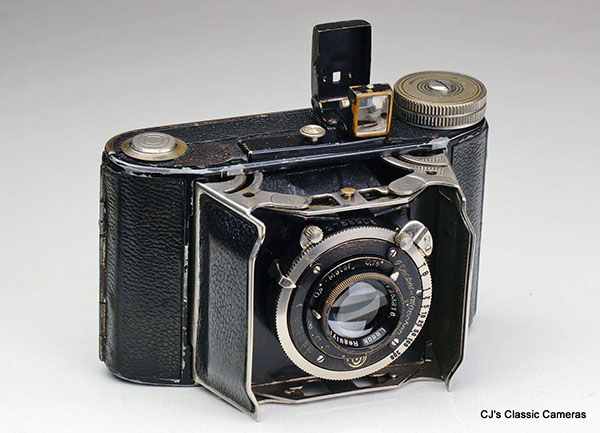
An unbranded (copy of?) Rodenstock Rodinett/Glunz Ingo with Laack Regulyt 50mm f/2.9 lens in Compur shutter. Note the curved doors, typically found on the Rodinett. The Regulyt is quite an unusual lens, especially in this focal length, but I have found no info about it that might help finding out which company sold this camera.
The Glunz Ingo was typically equipped with a Rodenstock f/4.5 or f/2.9 Trinar-Anastigmat lens in Compur shutter, and it is therefore perhaps no surprise that Rodenstock sold a rebadged version of the Ingo as the Rodinett. However, there were some differences, which I have not seen documented anywhere else before: whereas the Ingo had straight doors, those of the Rodinett were curved, and the Rodinett had a helical focus mechanism, whereas the Ingo had a front-cell focussing lens. The helical focus is probably the reason behind the curved doors, as it allowed more space and one did not need to set the lens to infinity to be able to close the doors. Somewhat curiously, the Rodinett did come with a different Rodenstock lens than the Ingo: a 50mm f3/.5 Ysar.
To confuse matters, another variant of the Ingo could be found, which had curved doors like the Rodinett but with a front-cell focussing Laack lens, and which did not bear the name Glunz or Rodenstock (or any other, see photos). Was this perhaps another rebranded version?
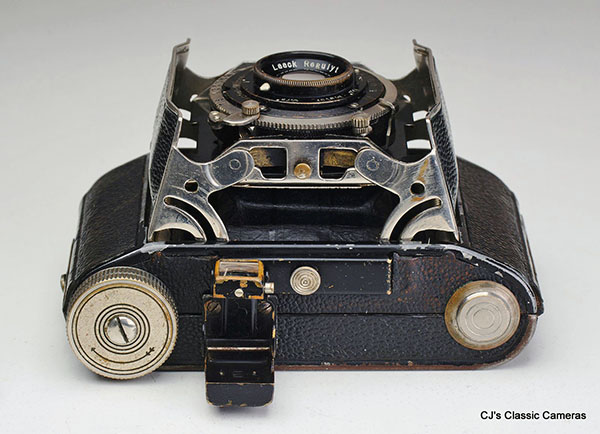
Top view of the Rodenstock Rodinett/Glunz Ingo showing its strut mechanism.
Kochmann Korelle 6x4.5
Kochmann was a relatively small camera producer from Dresden, that made a wide range of camera, exemplified by the fact that the ones in my collection are all spread over different pages (e.g., Korelle K, Reflex Korelle, Meyer Megor). However, Korelle are mostly known for their folding medium format cameras, of which the one shown here is an example. There is quite a variety of them, but identifying various models is hampered by the habit of Kochmann to name them all the same. There are 127 and 120 film models, and some have helical focus, others foldable viewfinders, there various back designs including variants which appear to have automatic frame counters, there were square and half frame format versions, and so on. A collector's dream, or nightmare!
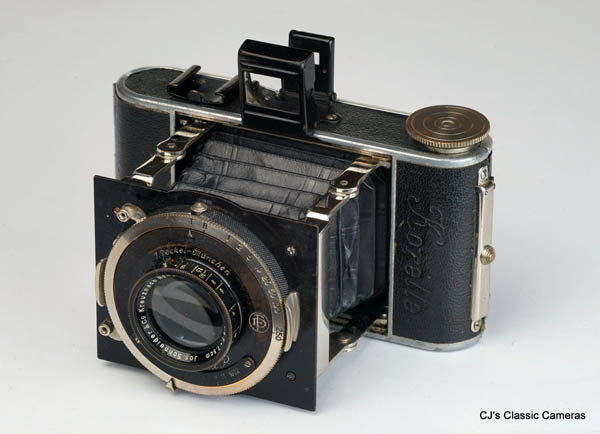
Kochmann Korelle 6x4.5 with Schneider Xenar 75mm f/3.5 lens in Compur shutter. The strut mechanism is quite unique but very effective and keeps the lens board parallel to the film frame well. Some versions had an extra front door to protect lens and shutter.
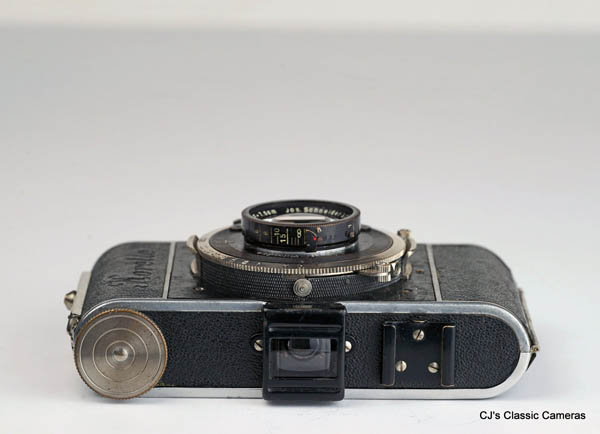
Top view of the Kochmann Korelle 6x4.5 with struts contracted. It folded up to a very compact package. Mouse move over to see struts extended.
The Camera Co. Vauxhall
The camera below is a rebadged Wirgin Wirginex, also known as Wirgin Baky, sold under the name Vauxhall by The Camera Co., a camera reseller based in London in the 1950s. This company sold several other cameras under the same Vauxhall name, of which a rebranded Beier Rifax is the one mostly commonly encountered these days. The Wirgin Wirginex was a 6x4.5 folding camera made of bakelite, at the time (mid 1930s) a relatively new plastic material. The Wirginex itself is a rather uncommon camera, so it took me a while to figure out what the origin of this Vauxhaull was.
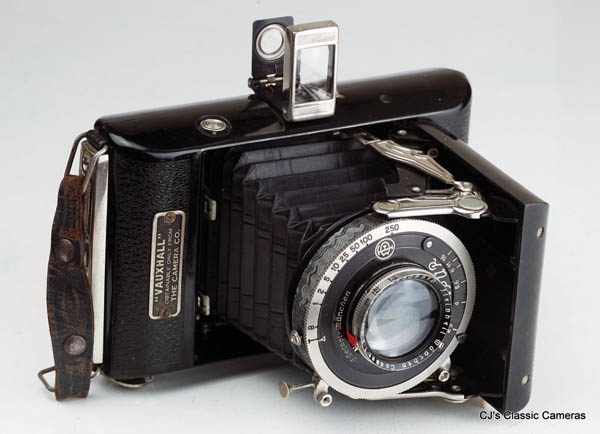
A Vauxhall with Steinheil Cassar 75mm f/2.9 lens in Compur shutter. Rather unusually, the Compur shutter has no serial number, which is normally engraved on the outer rim. There's a badge on the camera with the address of the Camera Co.: 320 Vauxhall Bridge Road, London, which explains the name of the camera, but that's about all the information I could find. It's no longer there. The second address listed (52 Cheapside) was occupied by City Sale & Exchange until 1930, at which point it became part of Wallace Heaton and moved down the road. I didn't find any further info about the Camera Co at this address either.
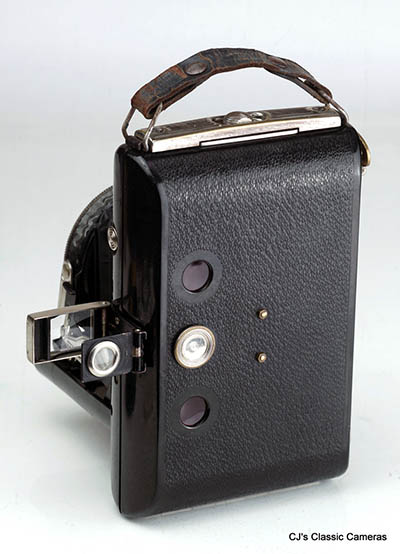
| |
Rear view of the Vauxhall. Note the leather pattern on the back, this was not actual leather but textured bakelite, one of the advantages of using this material. One of the drawbacks is that it wasn't as strong as metal and more difficult to make screw threads, therefore nuts and bolts were used to attach other parts to it. The two bolts in the middle of the back hold the pressure plate inside the film chamber.
|
Plaubel Makina IIS
Plaubel was a camera maker from Frankfurt which was founded in the early 1900s. Its main line of cameras was the Makina, a for the time rather unique 6x9 plate camera with a scissors strut-and-focus mechanism on which the whole front of the camera was mounted. It was produced for almost half a century, during which increasingly advanced features were added, most importantly a rangefinder and an interchangeable lens mount. The camera was generally sold with interchangeable film back for 120 roll film, and as such can still be quite easily used today. An almost exact copy of the Makina was produced by Chioyoda, the company that later became Minolta, and this copy was in fact the first camera model to carry that name.
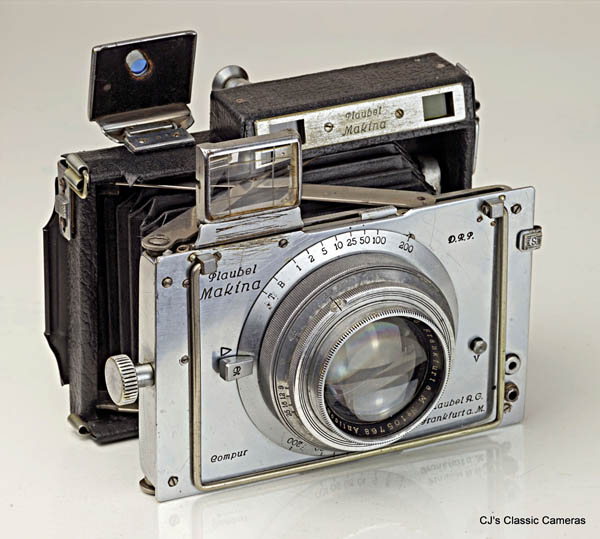
A Plaubel Makina IIS from the late 1930s with Anticomar 100 mm f/2.9 lens in Compur shutter. This example was in rather poor condition when I got it, and most of the leather had gone so I had to redress it. The lens is good and the shutter works (again), but the leather of the bellows still has a lot of holes and has stiffened, so the camera doesn't close completely. Finding replacement bellows isn't going to be easy though.
Other cameras by Plaubel were the Roll-Op, a medium-format folding rangefinder, the 3x4 Makinette, and the Veriwide 100, essentially a medium-format panorama camera. The name Plaubel Makina lived on after the company was sold to a Japanese company in the 1970s. The new owners introduced the Makina 67, a much modernised high-quality rangefinder version, interestingly still featuring a bellows system and highly sought after nowadays.
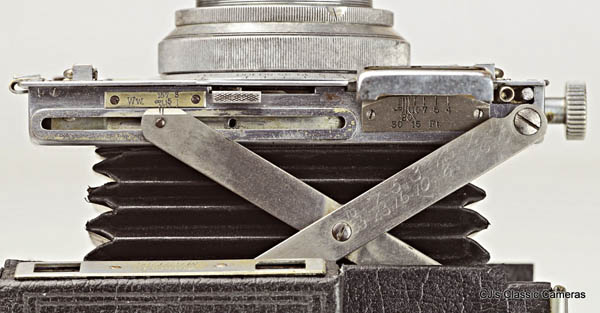
Top view of the strut and focus mechanism of the Plaubel Makina IIS. To use a wide angle lens, the focus scale as well as the strut position needed to be adjusted to compensate for the shorter focal length. One can see the wide angle scale to the left, just beneath the front plate. The standard scale is behind the viewfinder window to the right. Focussing was done with the focus knob to the far right - turning it would extend or retract the struts.
Beier Rifax
Beier was a company based in Freital near Dresden, the centre of German camera manufacture before WWII, and the same town as Welta was based. It was a fairly small company mainly known for its range of Beirette cameras, of which several examples can be found elsewhere on this site. It also produced an early 35mm camera, the Beira, which also can be found on the Beirette page just mentioned. The Beier Rifax was one of the many folding cameras that Beier produced before WWII. It was available as a 6x6 as well as a 6x9 medium format cameras which used 120 film. The most advanced Rifax was the 6x9 model with coupled rangefinder, which is the one shown below. The rangefinder was the split mirror type and had a separate viewfinder window. The camera was provided with a mask for 6x4.5 exposure, which would double the amount of photos one could take with one film. A nice touch is that the viewfinder came with small masks as well. The camera had a shutter release build into the front door, not unlike the Voigtlander Bessa. As slight oddity was that despite having a rangefinder, it still had the small waist-level viewfinder common on viewfinder folders of that era.
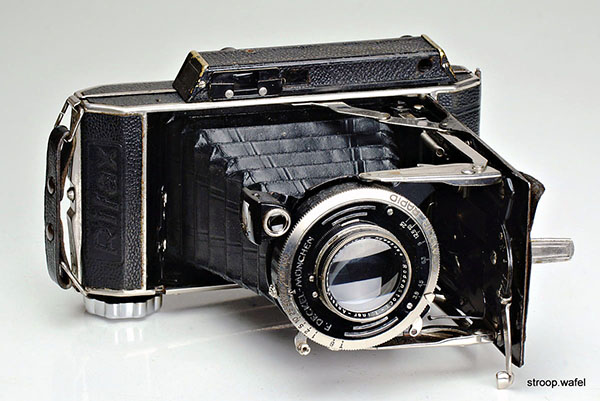
A Beier Rifax with Rodenstock-Trinar-Anastigmat 105mm f/3.8 lens in Compur-Rapid shutter. Note that the stand which the camera leans on is the focus lever. By rotating it the whole shutter/lens assembly would be pulled forward, the rangefinder would move simultaneously.
Beier Precisa II
The Precisa was Beier's 6x6 folding camera for 120 rollfilm, which with a film frame mask could also be used for the 6x4.5 format. It was introduced around 1936 as a camera with a a fold-up viewfinder, which incidentally was the only model that was for the 6x4.5 format only. It was continued after WWII, and like so many cameras updated with a larger top housing with a fixed viewfinder (the Precisa II). An uncoupled rangefinder version, the Precisa IIa, was also produced.
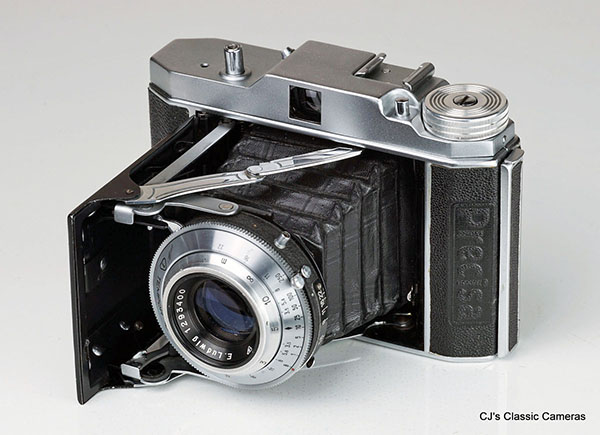
A Beier Precisa II with E. Ludwig Meritar 75mm f/3.5 lens in Tempor shutter. It has one of the best strut mechanisms I have encountered, there's virtually no play in the extended struts or the lens board at all.
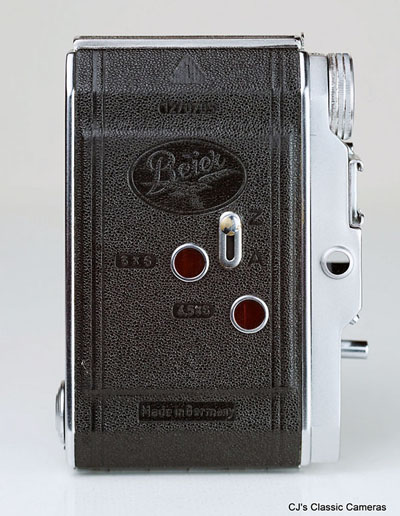
|
|
Rear view of the Beier Precisa showing the two different red windows for 6x6 and 6x4.5 frame size, as well as the Beier logo. This particular example had a small surprise for me: the whole backdoor came of soon after I got it! It turned out that it must have broken in the past and was poorly repaired with epoxy. The rivets that fix the door hinge to the body had sheared off, but thankfully these could easily be punched out and replaced by screws, so thankfully an easy fix after the initial shock.
|
Braun Norca Super
Like many camera makers that only started after WWII, Braun mainly produced 35mm fixed body cameras, in particular the Paxette range, a few medium format cameras, including the Gloria and Paxina, and only one folding camera, the Norca, which came in several different variants. They were all 6x9 cameras for 120 roll film that could also be used in 6x6 mode by means of an internal mask, with a simple viewfinder and front cell focussing lens, body-mounted shutter release, and some, the Norca Supers, had an extinction meter (making them look like a rangefinder, a sneaky sales tactic perhaps?).
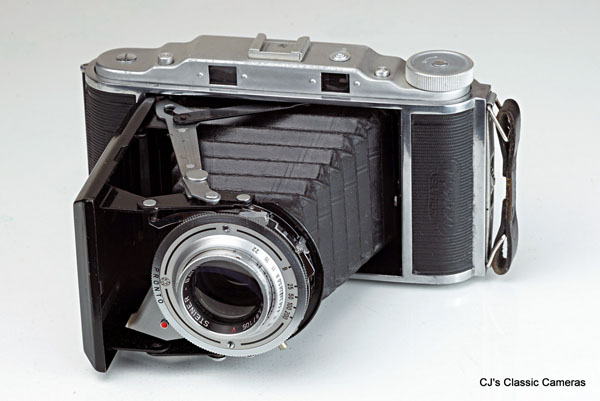
A Braun Norca Super with Steiner-Bayreuth Steinar 105mm f/3.8 lens in Pronto shutter. There are some internet sources that assign model numbers in part based on the lens on the camera, but interestingly this lens isn't listed, even though it's the one I most commonly see on Norcas listed for sale.
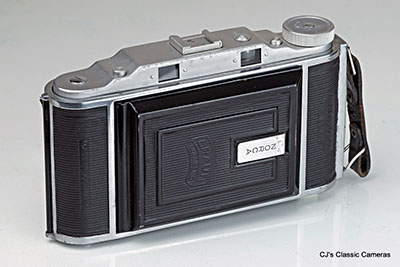
| |
View of the Braun Norca Super with the front closed, showing the name of the camera on the stand and Braun embossed in the leather.
|
Graflex Miniature Speed Graphic
If you are watching a movie set in the 1930s to 1950s and you see a scene with journalists carrying large cameras with tall flash units, it's quite likely you're looking at a Graflex press camera. Graflex was an American camera maker that dominated the press camera market. Press cameras were generally large format cameras with rack and pinion focus mounts and focal plane shutters. The Miniature Speed Graphic shown here was a post-war model that had a rangefinder and leaf shutter as additional features. Note it still had the focal plane shutter, so the photographer had a choice which one to use. The leaf shutter allowed for faster flash sync speeds. 'Miniature' referred to the camera's format, which was 2-1/4x3-1/4" (a fraction narrower than 6x9), relatively small for a film back camera.
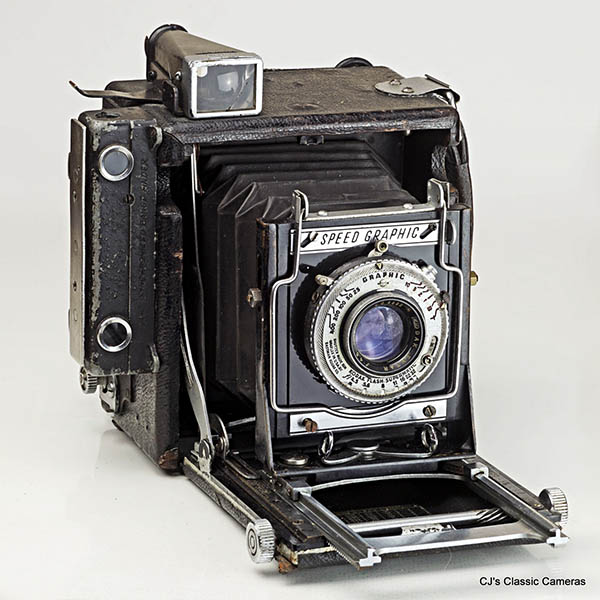
A Graflex Miniature Speed Graphic which has had a fairly hard life, perhaps not unexpected for a press camera. The leaf shutter is a Kodak Flash Supermatic, also found on the Kodak Medallist II, and the lens a Kodak Ektar 101 mm f/4.5.
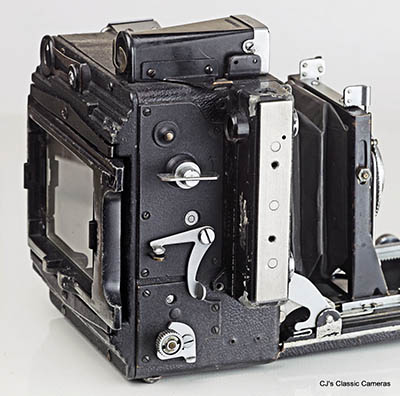
| |
Side view of the Speed Graphic showing the focal plane shutter controls, which consisted of a wind knob that could be turned several times to alter the spacing between front and rear curtain, the setting was indicated by a number in a small window below it (showing zero in this image). At the bottom is the speed adjustment knob (here set to 5), a higher number would make the shutter curtains move faster. The combination of the two settings (curtain spacing and speed) allowed a wide range of shutter speeds.
|
Certo Dollina II 'Dresden 46'
Certo is perhaps one of the lesser known Dresdner camera manufacturers, but at the time (1930s-1960s) its cameras had a good reputation. The Dollina range was a series of 35mm folding cameras first produced in 1935, at about the same time as Kodak introduced their first Retina. The first Dollina rangefinder was essentially a viewfinder model with an additional rangefinder unit mounted on top. This wasn't unusual, many manufacturers made their first rangefinders models that way. The Dollina featured a rather unusual focussing mechanism: a knob on top of the rangefinder moved the lens base forwards and backwards whilst adjusting the rangefinder at the same time.

A Certo Dollina II with Steinheil Munchen Cassar 45 mm f/2.9 lens in Compur shutter. Steinheil lenses aren't easy to date as I am not aware of a list that matches serial numbers with production dates, but this is the earliest one in my collection. The shutter serial would suggest the camera dates probably from 1935, but apparently this model wasn't introduced until 1936.
A little hard to read but the rangefinder says 'Certo Dollina Dresden 46' (not Dollina II). There's some discussion about this on the internet, but the most likely explanation is that the Certo factories were located in postal district 46 in Dresden. Later production examples only have the name 'Dollina'.

|
Side view of a Certo Dollina II to show the folding strut mechanism. The struts weren't fixed but were part of the focussing mechanism.
|
Certo Super Dollina II
The Certo Super Dollina II was first introduced in 1951 and featured a coupled rangefinder. The magnified coincidence rangefinder was separate from the viewfinder and coupled to the lens; in typical Certo style they were adjusted by a knob on the top housing. One could also read the distance at the top of the camera but this was not needed for the camera to function.
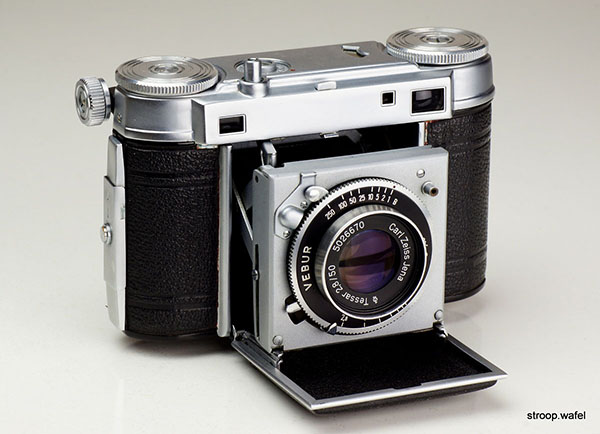
A Certo Super Dollina II with Carl Zeiss Jena Tessar lens in Vebur shutter. The lens serial number suggests this particular camera was produced in 1958. It was a well-made camera and would have been a joy to use, but the rangefinder adjustment is unfortunately rather tricky, so if it is off (like on this one) it will be hard to turn it into a usable camera again.
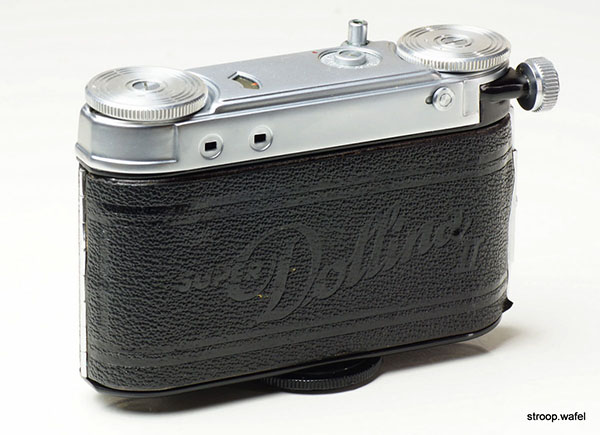
Rear view of the Dollina showing its name in the embossed leather. The small knob on the far right is the focussing knob which moves the rangefinder and the lens.
Certo Durata
The Certo Durata was a simpler and very compact 35mm camera compared to the Dollina above, and was introduced a few years after the end of WWII. Although based on the same body, including front door and strut mechanism, the Duratas lacked rangefinders and had front-cell focussing mechanisms instead of unit cell focussing. The first model, simply named Durata, was a small camera with a pop-up viewfinder. It could be found with Prontor II, Compur-Rapid or Ovus shutter, and a variety of lenses such as a Rodenstock Trinar, Meyer Trioplan of CZJ Tessar. The Durata II looked very similar to the Super Dollina II above, with a viewfinder build into a chrome-plated top housing, but was functionally not much different than its predecessor.
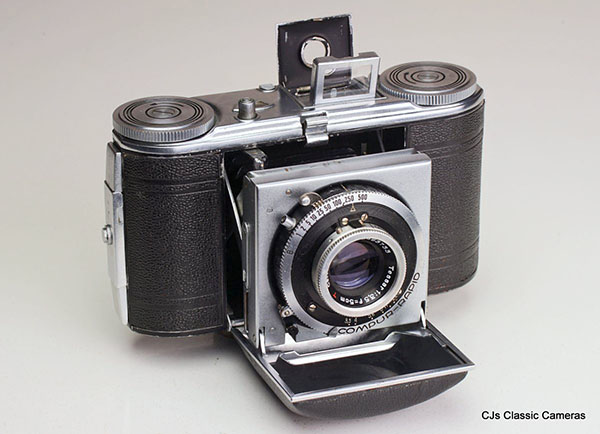
A Certo Durata with Carl Zeiss JenaT Tessar 50mm f/3.5 lens in Compur-Rapid shutter. It looks a little like the Voigtlander Vito II when closed, but the front door opens downwards instead of sidewards.
Certo Six
The Certo Six was a 6x6 camera for 120 rollfilm with some quirky features that clearly set it apart from contemporary folders like the Ikonta and Baldix ranges. First, it had a wind lever, a very welcome feature although unfortunately it did not cock the shutter, which still needed to be done by hand. Second, it had a focus lever at the bottom of the camera (when unfolded) which was best operated by one's thumb. Finally, it was parallax corrected by moving the lens closer to the viewfinder during close-focusing instead of the other way around like most cameras. It was a very well-build and sturdy camera although there are many reports of the rangefinder semi-transparent mirror fading with time. It was the last great camera build by Certo, which for unclear reasons moved to producing cheap plastic cameras instead.
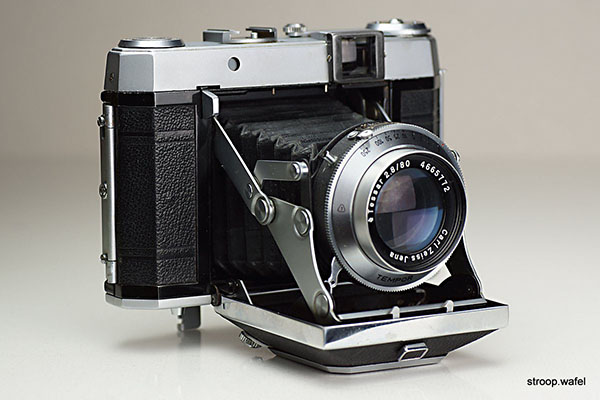
A Certo Six with Carl Zeiss Jena Tessar 80mm f/2.8 lens in Tempor shutter. It was also available with a Meyer-Optik f/3.5 lens and Synchro-Compur or Prontor-SVS shutter.
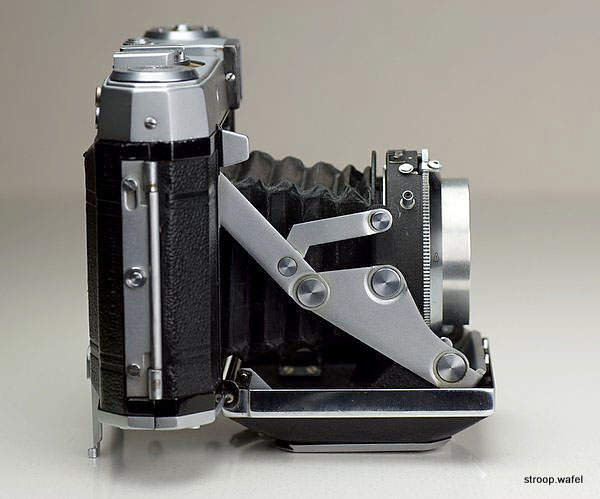
The Certo Six had a parallax corrected rangefinder, but instead of moving the viewing frame it was the lens itself that moved relative to the centre of the film frame. Move the mouse over the photo to see the difference between infinity and closest focus (1.5 m). The focus lever is visible at the bottom of the lens door in close focus position.
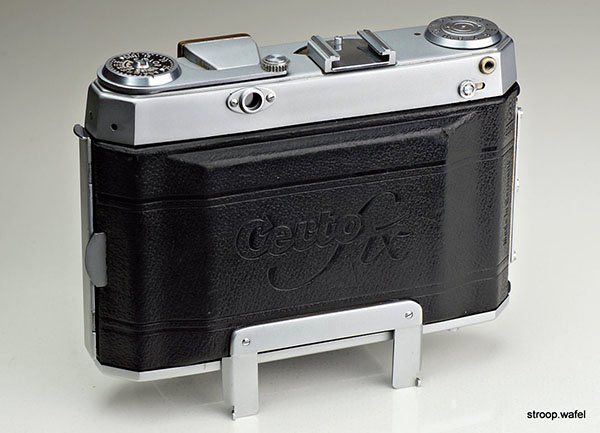
Rear view of the Certo Six. A nice feature was the build-in folding stand. The small button on the top right is the double-exposure lock reset, right above it is the remote release socket - perhaps not the most obvious location.
Franka Solida IIIE
The Franka Solida IIIE was a 6x6 rollfilm camera with uncoupled rangefinder that bore some resemblance to the Balda Mess-Baldix. The Solida I, II and III mainly differed in lens speeds, f/4.5, f/3.5 and f/2.9, respectively. The E version had uncoupled rangefinders (E = 'Entfernungsmesser'), whereas L versions with light meter were also available (see below for an example). Several versions existed, e.g., early Solidas had separate rangefinder and viewfinder windows, and the location of the distance dial of the uncoupled rangefinder changed.
Franka Kamerawerk was based in Bayreuth and a rather small player in the German camera production. Nevertheless, it did produce a wide range of cameras, like the above-mentioned Solida folding camera range as well as the fixed-lens Franka and Frankarette. The company was in 1962 taken over by Wirgin.
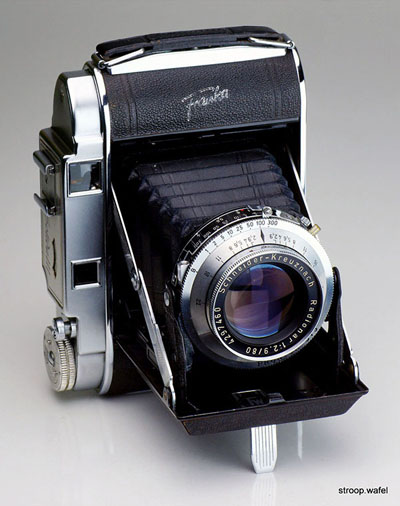 |
A late Franka Solida IIIE from 1955 with Schneider Radionar 80mm f/2.9 lens. |
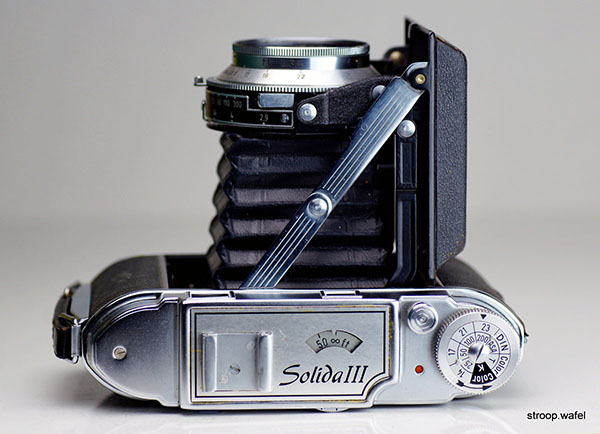
Top view of a Franka Solida IIIE showing the rangefinder distance indicator and wind knob with double exposure prevention.
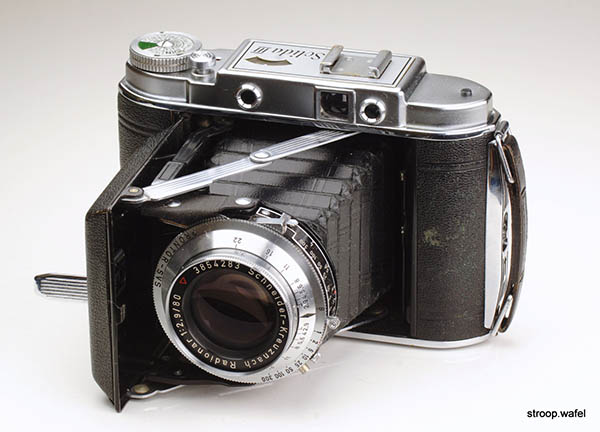
Early version of the Franka Solida IIIE with separate viewfinder and rangefinder windows. The back of the camera is marked 'Made in Germany US Zone'.
Franka Solida IIE
The Franka Solida IIE was very similar to the Solida IIIE above apart from two important differences: the lens had a slower f/3.5 maximum aperture and it had a downwards opening front door with a different strut mechanism. This made the camera look quite different from its more expensive sibling.
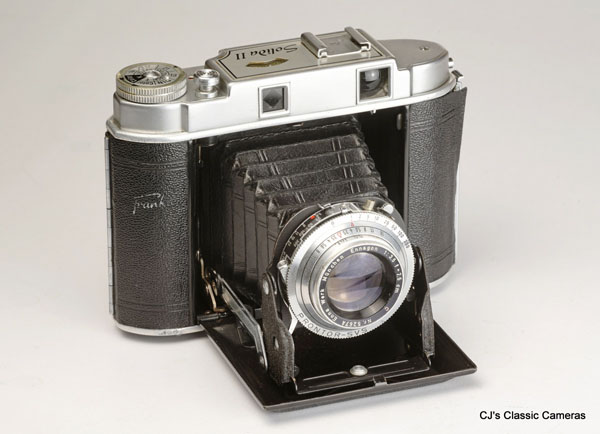
Franka Solida IIE with Enna Werk Ennagon 75 mm f/3.5 lens in Prontor-SVS shutter.
Franka Solida IIL
As one can infer from the name (see above under Solida IIIE), the Franka Solida IIL was a 6x6 rollfilm camera with uncoupled lightmeter. To fit the lightmeter the top housing needed to be enlarged compared to the non-lightmeter models, which is why this model looks a little more square than the Solida IIIE above. In addition, the front door would open downwards rather than sideways, as was also the case on the Solida IIE, and I never quite understood why this was. From most angles the Solida II and II look nearly identical, yet they have a different door mechanism. All I can think is that it must have been cheaper to produce, and worth making a different body.
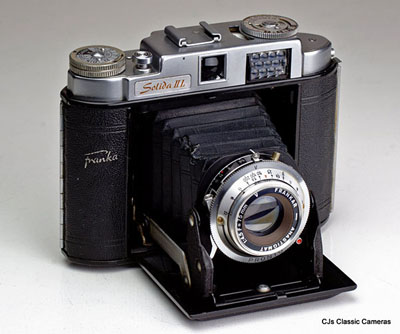
|
Franka Solida IIL with, somewhat surprisingly, a 75mm f/4.5 lens. I say surprisingly because Solida II models generally had f/3.5 lenses, whereas the slower f/4.5 lenses could be found on the Solida I models. Note that on this example the flap of the lightmeter has broken off.
|
Franka Rolfix IIE
The Franka Rolfix II was the big brother of the early Solida IIIE above. It was essentially the 6x9 rollfilm version of that camera, but it could also be used for 6x6 photos by means of frame on the film gate. To assist this there was a switch on the top housing to switch the viewfinder between and on the back of the camera there were two separate red spy windows, one for 6x9 and one for 6x6 exposures. The Rolfix had a body mounted shutter release and a double exposure prevention mechanism.
The Franka Rollfix II came with a 105mm f.3.5 lens. I have never seen a Rolfix I, but if the naming system was the same as for the Solida, it would have been similar to the Rolfix II but with a slower f/4.5 lens. Likewise, the E version would have had an uncoupled rangefinder (E = 'Entfernungsmesser'), like the example below. Older versions of the camera with a fold-up viewfinder were also produced.
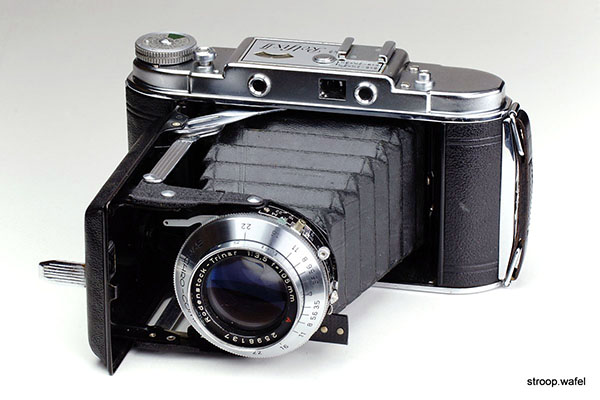
Franka Rolfix IIE with Rodenstock-Trinar 105mm f/3.5 lens in Synchro-Compur shutter. The serial# of the lens dates this camera to around 1952. Like the early production Franka Solida IIIE above, it had separate viewfinder and rangefinder windows and the back was marked 'Made in Germany US Zone'.
The Rolfix has a 6x6 mode but that does not give the same result as a 'native' 6x6 camera like the Franka Solida, as shown by this comparison of fields of view of the Rollfix II with its 6x6 mask and 105mm lens, and the 6x6 Solida with 80 mm lens. The Solida field of view is clearly 'wider' than the Rolfix.
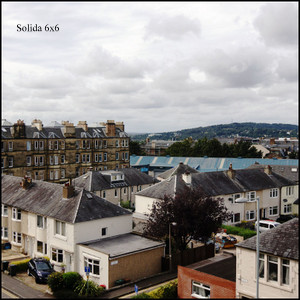
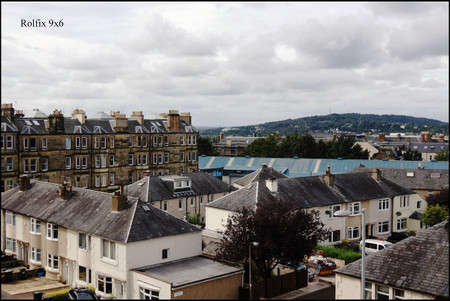
Comparison of fields of view of the Rolfix II 9x6 camera with 105mm lens and the Solida 6x6 camera with 80 mm lens. Due to the smaller focal length of the Solida, its field of view is not much narrower than the Rolfix with its wider frame size, but shows more at the top and bottom of the frame. The Rolfix 9x6 field of view is equivalent to that of a 45mm lens on a 35mm film.
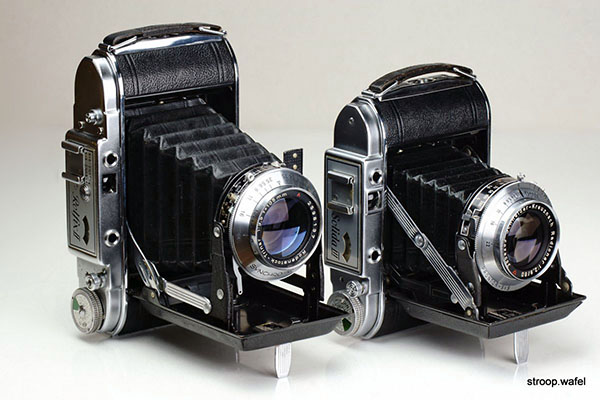
A Franka Rolfix IIE 9x6 and its smaller sibbling Solida IIIE 6x6 side by side.
Adox Mess Golf
Long before the Volkswagen Golf there was a different German Golf: the Adox Golf. Not a car obviously, but a medium format folding camera. Adox can be encountered elsewhere on this site on the Wirgin Gewirette/Edinex page, as it took over production (and factories) of these cameras when the Wirgin brothers had to flee Germany at the end of the 1930s. After WWII the Wirgin brothers reclaimed their equipment, but Adox stayed active selling photographic supplies (the Adox name still exists: www.adox.de) as well as a small-scale camera producer. Their most remarkable contribution was without doubt the magnificent Adox 300, a 35mm camera with exchangeable film back, found here.
Anyhow, the Adox Golf range was a series of 6x6 folding cameras introduced in the 1950s that were quite similar to the Agfa Isolette and Zeiss Ikon Nettar range. Nothing fancy but dependable and available with decent lenses and shutters. Most commonly encountered are the simple viewfinder models, but a uncoupled rangefinder model was also produced, this was the Adox Mess Golf (Mess is German for 'measure', referring to the rangefinder used to measure the subject distance, a term also used by other camera makers, e.g., the Mess Ikonta and Mess Baldix). The Mess Golf was the last incarnation of the Adox Golf as a folding camera, but the name Golf was used again in the 1960s for a range of 35mm cameras, and a decade later again, by Volkswagen this time, for the famous car.
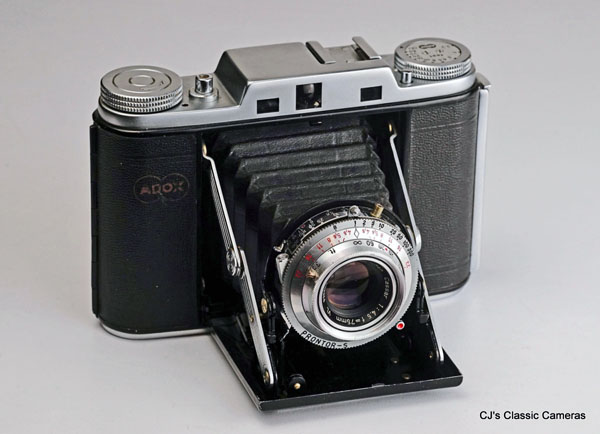
Adox Golf with uncoupled rangefinder, the dial for which can be seen on the top right. The camera had a separate viewfinder. This example has a Steinheil Cassar 75mm f/4.5 lens in Prontor-S shutter. The Cassar is quite rare in this focal length; it's much more commonly encountered as 45 or 50 mm lens on 35 mm cameras. A Mess Golf version with faster f/3.5 aperture was also available.
Dacora Royal
Dacora was mostly known as a company producing cameras for others (see Ilford Sportsman) and was certainly not known for its innovative designs. However, the Dacora Royal was a bit of an exception, as it was one of the few 6x6 folding cameras to sport a windlever for film transport and shutter cocking. Although this feature was common on 35mm cameras, it had been difficult to implement on rollfilm cameras. The camera also featured an uncoupled rangefinder and was otherwise fairly unremarkable.
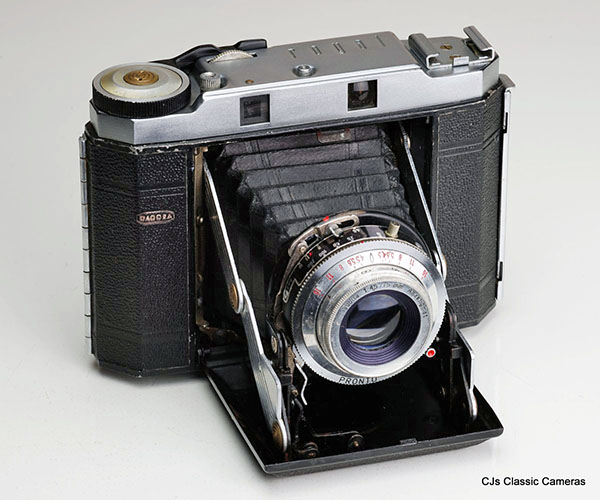
Dacora Royal with Subita 75mm f/4.5 lens, a lens I have otherwise never heard of, and Pronto shutter. The Royal was also available with better speficied lens and shutter, e.g, Enna Ennagon lens and Prontor-SVS shutter like found on the Balda Baldix.
Nixon Nixette
The Nixon Nixette was quite a unique folding camera, and not just because of its sleek top plate with unconventional wind knob giving the camera an attractive Art Deco look. No, the main peculiarity was the origami style way the bellows were folded when closing the camera. Not sure why no other companies had thought of this or why it did not catch on. There's a lot less opportunity for light leaks on the folds and it must be easier and thus cheaper to make. Due to the impressive tension on the spring that extends the struts, opening the camera is also a sight to behold, it could easily double as a mouse trap.
Other than that it was a pretty standard folding camera in 6x6 format for 120 rollfilm with a simple Vario shutter and quite slow f/5.6 lens of unknown make, branded Supra-Anastigmat. The shutter needed to be cocked by hand and the shutter release was also mounted on the shutter itself. The camera was also sold as Gerlach Trixette. A version with two viewfinder windows was also available, but one is blank, so it was not a rangefinder. Bit cheeky! A rare version with similar body style but with a collapsible lens tube instead of the folding bellows was sold as the 'Ideal' (see here). Gerlach also made the 35mm Ideal Color 35 elsewhere on this site.
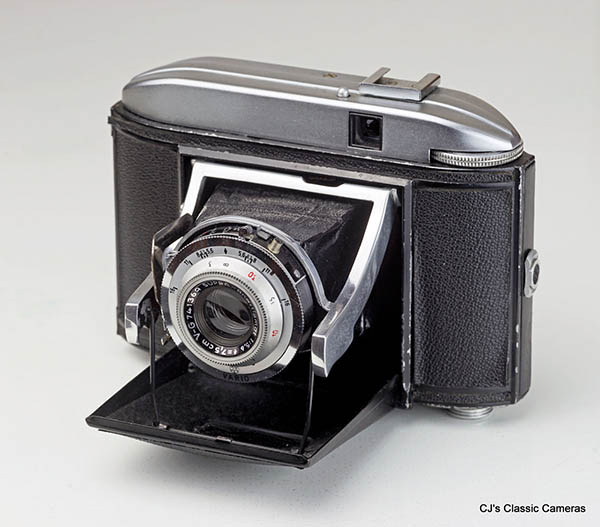
Nixon Nixette with Supra-Anastigmat V-G 75mm f/5.6 lens in Vario shutter.
Shanghai 203
China is not a country known for their cameras, but they did in fact produce a small range of quite decent quality cameras already in the 1950s and 60s. The Shanghai 203 was one of these. It was a 6x6 rangefinder for 120 film which was clearly inspired by the last model of the Zeiss Super Ikonta range, although lacking the lightmeter (having just an exposure calculator instead) but with a wind lever for film transport, which was quite an advanced feature. However, film transport wasn't automated, so one still needed the red spy window at the back to check the film advance, but the wind lever was still much preferable over a wind knob.
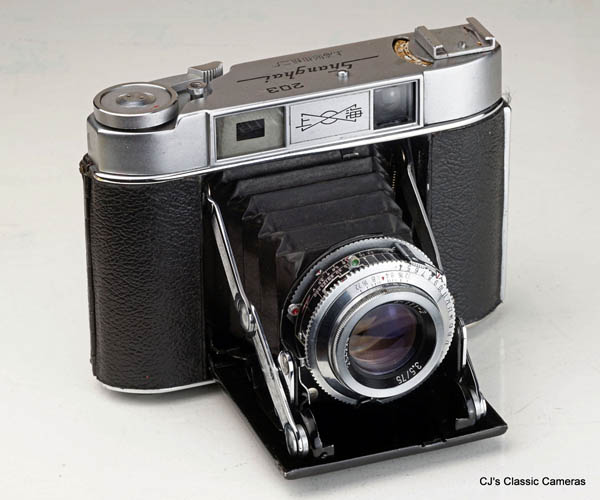
Shanghai 203 with coated S-111-2 75mm/3.5 lens in unnamed shutter. The accessory shoe was added later at the expense of an exposure meter dial, the scale of which is still present.
The Shanghai 203 was later renamed to Seagull 203, which had a different logo at the front but was otherwise nearly identical. There are some sources on the internet saying that the original version had a better lens, but I believe they had the same name so this is hard to verify.
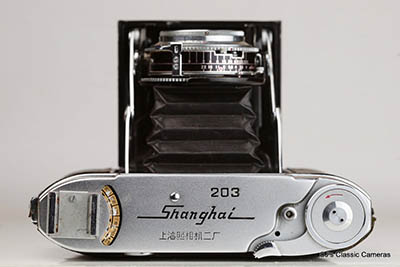
| |
Top view of the Shanghai 203. Note that originally an exposure dial would have been located where the accessory is located now.
|
|

